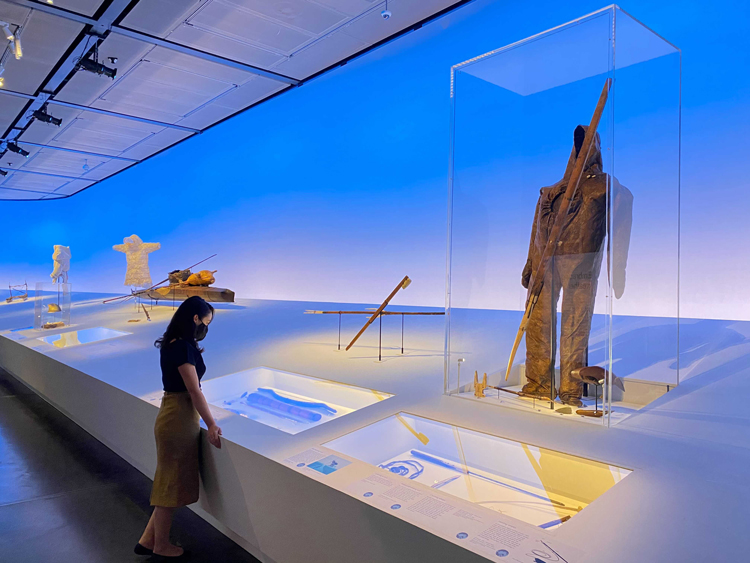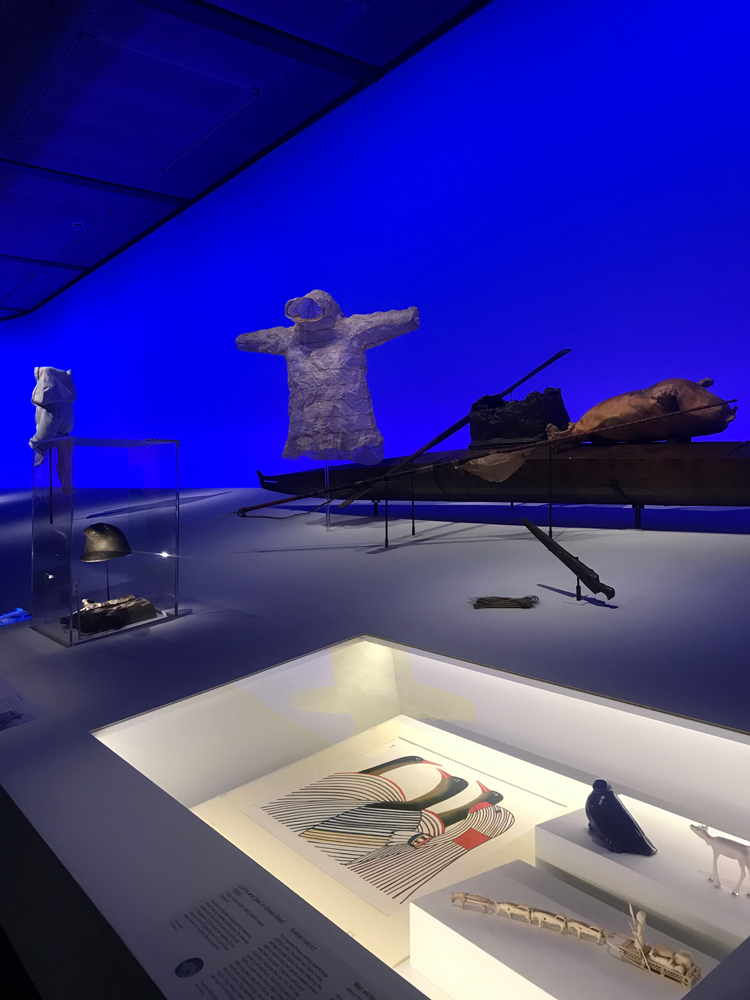Opera studio brings the Arctic to the British Museum with climate change exhibition
Featuring mammoth tusks and refitted snowmobiles, Arctic: Culture and Climate is designed to evoke the polar landscape in an “abstract” way.
The Arctic will be ice-free in 80 years, scientists predict. In light of this stark warning, the British Museum’s latest exhibition Arctic: Culture and Climate seeks to highlight the “dramatic and profound change” affecting the region and its people.
The changes affecting the most northern region of the world (which covers 4% of Earth) will not only affect those living there – they will “affect us all”, the museum says.
It is the first major exhibition on the history of the Arctic and its indigenous peoples through the lens of climate change, according to the museum, bringing together the “most diverse circumpolar collection ever displayed in the UK”.

This includes objects like a winter costume made of wild reindeer fur and a bag made from tanned salmon skin. There are also installations, which include a limestone Inuksuk – a traditional Arctic monument made of stacked stones which marks harvesting locations or to aid navigation. It’s been made by Piita Irniq, from the Kivalliq region of Nunavut, Canada.
According to the museum, the exhibition aims to celebrate “human achievement” among the landscape as well as how indigenous people are “transforming traditional heritage to meet contemporary needs and safeguard their culture”.
The archaeological finds and tools are juxtaposed with photographs and video footage of contemporary life in the Arctic.
“A sense of the Arctic”

It has been designed by Amsterdam-based studio Opera, and worked on remotely. Because of quarantine restrictions, the design team has not been able to carry out site visits.
Studio director Jeroen Luttikhuis tells Design Week that one of the aims of the design was to “convey a sense of the Arctic and its landscape” without being too “literal”.
On one side of the exhibition room is an expansive white platform, which runs down the entire wall. Behind this sloped wooden installation is a floor-to-ceiling white fabric. This platform is a “holder for objects”, the designer says, but it also provides a “light scape” which aims to show the changing seasons.
“We wanted to create a sense of atmosphere and the vastness of the landscape,” he adds. Luttikhuis and his design team worked from mock-ups and experimented with different lighting to try to find the best way to evoke the polar landscape.

The resulting 24-minute lightscape has been designed by Beam Lighting Design director Jono Kenyon and designer Lucy Record and represents the changing light over a year in the Arctic. Each month lasts two minutes with a one minute fade in-between states so that it always appears in flux.
This work was carried out in collaboration with the exhibition curator Amber Lincoln, who has spent time in the Arctic. Light is an important aspect to the Arctic landscape: while the sun is absent during the winter, the sun contributes to the Northern Lights which can be seen in the region.
Throughout this process, it was key to find the balance “reality and abstract thinking,” Luttikhuis says. At one point, the team had considered putting a “huge projection” along the wall though budgets restricted this.
The result, he hopes, is more like a “beautiful theatre piece” which allows the visitor to “fill in” the space with some of their own details.
Bringing the humanity of the Arctic to life

This half of the exhibition is contrasted with the more “intimate displays” on the opposite side of the exhibition space, explains Opera 3D designer Mette Bos. According to Bos, the intention of this part of the design was to bring the human stories of the Arctic to life.
Visitors make their way through an architectural display installation with the help of social-distancing wayfinding graphics. Display cabinets show objects as well as screens with video footage. The area is dimly-lit, which again contrasts with the white platform opposite.
The installation is made of stained ply-wood which has a “washed finish”, she says. This allows the material to have a distinctive coloured finish while still showing off the grain. It was about giving the exhibition a “tactile” quality instead of simply using an “abstract MDF material”, Bos adds.
The wood colours (blue, red and yellow) are inspired by the colours of houses that can found in the Arctic. These help to “locate the visitors” in the exhibition, she adds. A floor-map in the first space also seeks to locate visitors, as does a globe wall-projection at the room’s entrance.
Throughout this side of the exhibition, there are large-scale lightboxes which illuminate photos of the Arctic’s indigenous peoples taken by photographer Brian Adams.
“One of the most important things to do was to have this sense of people inhabiting the space,” she says. “They’re placed on the same horizon as the platform so that you see people in the landscape.”
There are windows throughout the wooden display which provide a variety of “sightlines” throughout the exhibition, the design team says. The aim was to create a sense of the domestic interiors mixing with the polar landscape.
Interactive features have been removed because of Covid restrictions, Bos explains. Now there are QR codes for visitors to explore the exhibits in more depth online. A lot of the materials have been “reused” from previous exhibitions, the designer adds, such as glass cabinets from the museum’s past exhibition on Troy.
“Thinking about the future and the next generation”

A final immersive room displays hanging “parkas”. This is a new installation from collective Embassy of Imagination which presents traditional clothing designs made by Inuit Youth in Kinngait and Pangnirtung (both located in Canada).
Bos explains how these were originally displayed at a different point of the exhibition but were moved to the end to create a final “reflective space”.
In this separate room, which is painted a bright white colour, the clothes have been hung at different heights from the ceiling. This has been inspired by balloon lanterns that people float in the sky to make wishes, according to Bos.
“It aims to make us think about the future and the next generation,” she adds. “It’s no longer just thinking about us but also the children – as they the ones who have to deal with what we leave behind.”
Arctic: Culture and Climate runs from 22 October 2020-21 February 2021 at the British Museum, Great Russell Street, London WC1B 3DG.
Tickets cost £18 and more information is available on the website.






This was clearly designed for projection , a shame that the BM did not have the imagination/budget to see this through.